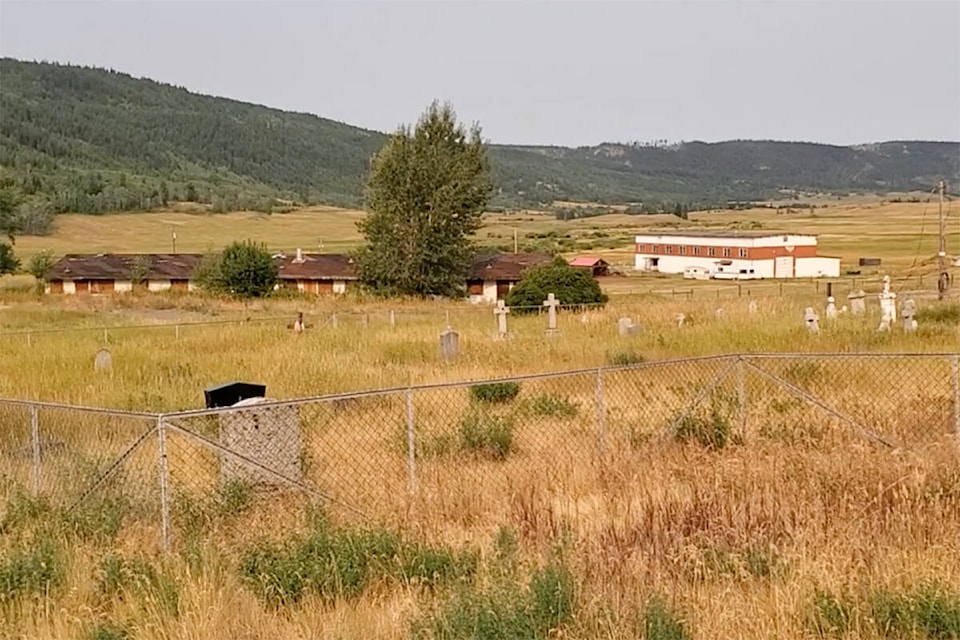The lead investigator in the search for unmarked graves at a former residential institution near the Williams Lake First Nation in central British Columbia said the latest phase of their work has uncovered 66 additional “reflections,” indicating children’s graves.
Whitney Spearing told a news conference that the results of Phase 2 of their investigation show there were crimes committed against children associated with the Catholic operation of St. Joseph’s Mission Residential School.
Spearing said in addition to the reflections found in a technical survey, their interviews with survivors and archival records revealed that babies born as a result of child sexual assault at the former Catholic mission were disposed of by incineration on and off-site.
Spearing said they found “a minimum” of 28 children died at the mission, which operated between 1886 and 1981, many of them buried in unmarked graves around the site.
A year ago, the nation announced the first phase of its investigation had uncovered 93 other “reflections.”
“Phase one looked at an area immediately adjacent to the historic buildings of the mission proper. Phase two is across the San Jose River by the railway right-of-way — so on the completely opposite side of the river,” she told Black Press Media.
Survivor interviews, testimony, traditional use interviews over the years, saw “tons” of people mention burials which made that an “obvious place to start.”
Williams Lake First Nation Chief Willie Sellers said the next steps will be to potentially exhume bodies in the areas that have already been scanned, showing a total of 159 possible unmarked graves.
He says children from 48 different nations attended the school, and engaging with those nations in the process of potentially exhuming bodies is a “scary thought.”
Phase three is already underway with archival and photographic research and field work will begin mid-March as soon as most of the snow is off the ground, Spearing said.
It will start with a pedestrian survey, which means walking over the area, followed up with the ground penetrating radar (GPR) work.
GeoScan, the company helping with the investigation, can give them 40 field days this season, she added.
“There is not a lot of capacity across the country to do GPR, and GeoScan has been pulled into another three or four investigations, so they are feeling the crunch. We don’t want to take bread out of anyone else’s basket. We want to ensure that everyone has access to their expertise.”
It is important for people to know the team is talking about excavation and exhumation, Spearing said, but emphasized there is a lot of leg work that needs to be done before any of those processes could even begin.
“I don’t want anyone to think we will be out there with shovels digging and attempting to find human remains next year. It’s not going to roll out that way.”
She said they will definitely be in contact with the coroner’s service and are also in contact with the church Oblates to gain control of the cemetery which is still owned by them.
Sellars said 30 chiefs from various nations and some of their staff attended an online session in the morning where the investigation results were shared with them before being made public.
“They asked lots of questions - the dialogue was great,” Sellars said. “They are thankful for information. That’s what everybody wants. They want to know what is going on.”
After the media conference, sharing the information, a sacred fire was lit outside the Elizabeth Grouse gym at WLFN’s Sugar Cane community with more than 100 people - First Nations and non-First Nations - standing in a large circle.
Various people sang drumming songs, some made food and tobacco offerings into the fire, and several people spoke - some about their experiences with residential school and trauma.
Sellars said the fire will continue until Saturday evening, culminating with a powwow demonstration, ceremony, feast and lahal.
“We are uplifting people with ceremony, but we are also hoping to inspire and strengthen people so that they can step forward and feel comfortable about telling their story,” he said. “We are finding at ceremonies survivors will share their stories and talk about their past.”
That’s not necessarily the case for a lot of residential school survivors, he added.
”People refuse to talk about it still and we need to get past that if we can and hold them up.”
Spearing and Sellars continued to encourage people to ask questions or share information with the team.
“Sitting down and having dialogue is how we are going to move through this, collectively. There has to be someone that leads the investigation, but hey, we need input and we want information as well,” Sellars said.
Thankful for the turnout at the sacred fire, he said seeing the number of non-First Nations people participate was “unbelievable.”
The Indian Residential Schools Resolution Health Support Program has a hotline to help residential school survivors and their relatives suffering with trauma invoked by the recall of past abuse. The number is 1-866-925-4419.
READ MORE: ‘93 is our number’: WLFN reveals St. Joseph’s Mission preliminary findings
www.facebook.com



